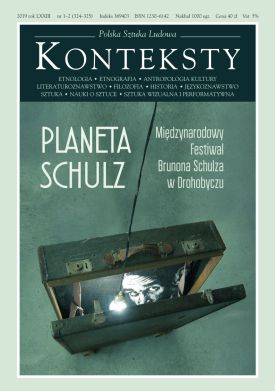Bruno Schulz a geografia środowisk artystycznych jego epoki. Relacja miejsca i twórczości plastycznej na wschodnich rubieżach Europy
Bruno Schulz and the Geography of the Artistic Milieus of His Epoch. The Relation between the Place and Visual-art Activity Along the Eastern Borders of Europe
Author(s): Marek TomaszewskiSubject(s): Social Sciences, Language and Literature Studies, Fine Arts / Performing Arts
Published by: Instytut Sztuki Polskiej Akademii Nauk
Keywords: Bruno Schulz;place
Summary/Abstract: Did Schulz belong to a certain milieu, which concentrated the strivings of a group of artists working in a certain delineated geographical region? Portraits and self-portraits, illustrations to own stories, drawn sketches to unwritten prose, notes marked with erotica – those vividly differentiated formulas of artistic expression do not facilitate the research pursued by critics. Apparently, Schulz found it less of an effort to create visual-art works than to write. Nonetheless, this does not signify universal triumph and recognition; to the last days of his creative life Schulz, already an acknowledged man of letters, cherished unfulfilled hope for artistic success. Upon numerous occasions he expressed regret that he was incapable of mastering the art of woodcutting. As a graphic artist, illustrator, and draughtsman he concentrated on his world of the imagination and tended to avoid participating in programme disputes. In the course of several decades there appeared numerous publications analysing Bruno Schulz’s attitude towards art. In Poland interesting interpretations were offered by Jerzy Ficowski, Małgorzata Kitowska-łysiak, Krystyna Kulig-Janarek, and Irena Kossowska and in France by Serge Fauchereau. In this essay Marek Tomaszewski wishes to delve into the character of Bruno Schulz’s artistic debut as a graphic artist and draughtsman within the range of a local milieu typical for ethnic and cultural differentiation, as well as to follow his artistic path and wide gamut of social life connections. It is a known fact that Schulz’s artistic Modernism assumed form, i.a. under the impact of East European Jewish avant-gardes, which could have won the recognition of the debuting artist from Drohobycz. Who were the artists with whom Bruno Schulz exhibited his graphic artworks? What is the relation between this period of strenuous although much censored (in the case of Schulz) artistic activity and reviews written by the author of Sklepy cynamonowe in “Przegląd Podkarpacia” at the end of the 1930s, dealing with such artists as Ephraim Moses Lilien or Feliks Lachowicz? Who belonged to the closest group of Schulz’s artist friends? In this essay Marek Tomaszewski attempts to resolve precisely those and other questions.
Journal: Konteksty
- Issue Year: 324/2019
- Issue No: 1-2
- Page Range: 123-128
- Page Count: 6
- Language: Polish
- Content File-PDF

